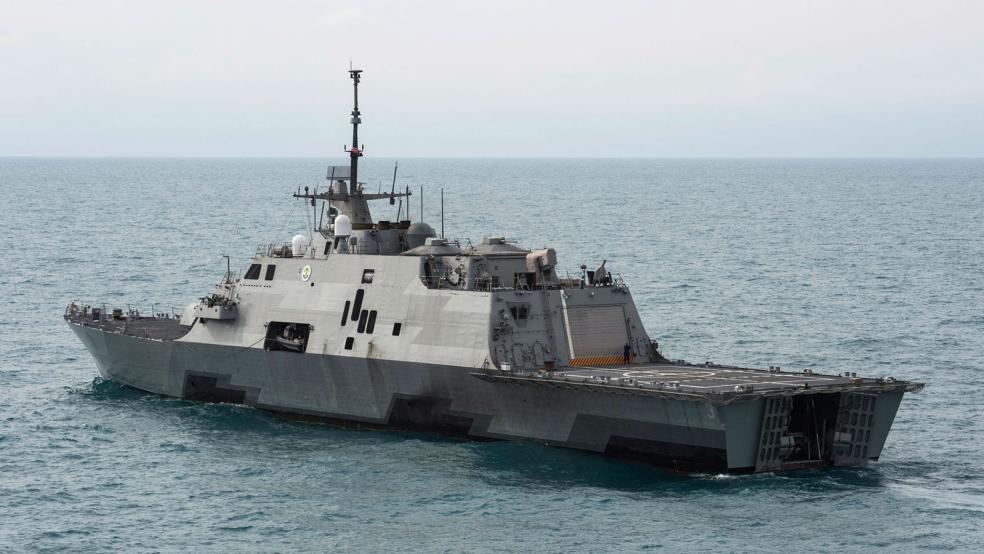After the all-too-predictable delays and cost overruns, the $12.9 billion USS Gerald R. Ford will finally be commissioned on July 22. However, it still won’t be ready for action, and the Navy may speed up deployment by forgoing shock tests.
In “full-ship shock trials,” massive explosions are set off near a vessel to test its structural strength. By skipping shock trials, Defense News says, the Navy will be able to have the Ford operational and deployed by 2019 or 2020.
Related: The Navy’s New Carrier Is Billions Over Budget – and the Next One Will Be Too
But short-cutting the development and testing process can lead to big bills for taxpayers when deficiencies have to be fixed further down the road.
In a report earlier this month, the General Accounting Office said that the $2.4 billion in overruns on the Ford were due to insufficient cost estimates and that going over budget on the next massive nuclear aircraft carrier under construction, the USS John F. Kennedy, seems likely.
In fact, the GAO has been relentless in calling out the military for throwing caution to the wind and rushing ahead with major weapons systems before they are ready. Here are some notable recent examples:
The USS Gerald R. Ford. As far back as 2007, the GAO said that the Ford’s costs were being underestimated and that “critical technologies were immature” – risks that would impair delivery and the ship’s ambitious package of capabilities.
When it is finally operational, the Ford will be at least $2.4 billion over budget, making it the most expensive ship ever built.
Related: A Fleet of ‘Lightning Carriers’: The Marines’ Big Plans for the F-35
In a 2015 report, the GAO said of the Ford, the first of an entirely new class of nuclear aircraft carriers: “Over the past eight years, the business case has predictably decayed in the form of cost growth, testing delays, and reduced capability—in essence, getting less for more.” It said tests of “key technologies” were put off for years while construction of the ship went forward.
Frigates and Littoral Combat Ships. In April, the GAO recommended delaying $9 billion in funding for 12 frigates – replacements for the troubled Littoral Combat Ship – “until at least fiscal year 2019 when sufficient cost, design, and capability knowledge is expected to be available to inform decisions.”
The GAO said the Navy is asking Congress for money to build ships that differ only slightly from a previous program fraught with problems, even though key design details won’t be available until 2018. There are “significant unknowns in regards to operational performance” of the frigates, and there is a strong likelihood that shipyards will not be available to build the vessels.
But such warnings seem to be ignored as the Navy rushes to build the 350-ship fleet Donald Trump promised on the campaign trail (legislation was introduced Thursday to raise the number to 355), even though the 2018 budget does not provide for any more vessels than were planned under Barack Obama.
Related: The Troubled F-35 Nails Its Paris Debut, Closes In on a $37 Billion Sales Deal
Earlier this week, the Navy said it had “found” $500 million to add a second LCS, designed for close-to-shore combat, to the fiscal 2018 budget. It plans to push ahead with construction despite the fact that, as a Bloomberg story said, the LCS “has been criticized by the Pentagon’s testing office, the Government Accountability Office and internal Navy studies that have questioned its costs, small crew and potential vulnerability.”
The F-35. Last spring, a story in Bloomberg Businessweek wondering whether the F-35 is a “trillion dollar mistake” pointed out that, “Beginning in 2007, the Pentagon accepted delivery of scores of planes, even as Lockheed continued to make design changes and address myriad deficiencies.”
Those deficiencies continue to this day. And they have helped contribute to what Businessweek said is a “38 percent increase from the initial 2001 estimate” for an aircraft that is seven years late.
As Michael Sullivan, director of defense acquisition oversight at the GAO told the magazine: The military “didn’t follow the old rule of ‘fly before you buy.’ ”





